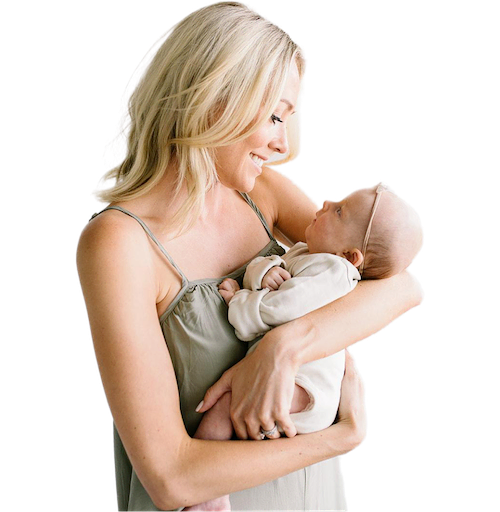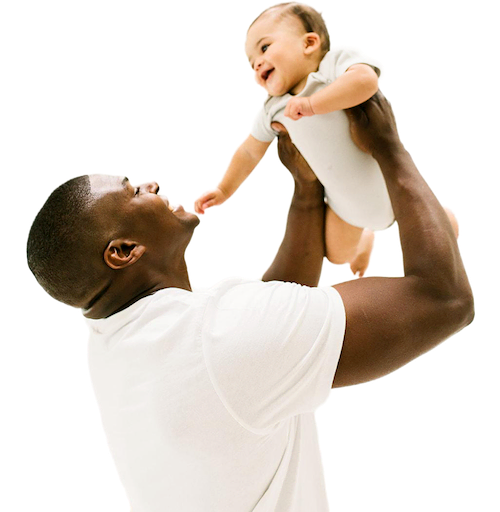If you Google the phrase “dream feed,” you find so many “rules” and opinions. Let me simplify it for you!
What is a dream feed? anchor
A dream feed is a planned feeding where you intentionally get your baby out of the crib or bassinet and offer a full feeding. This becomes the last feeding of your “day.” In theory, this added feeding will allow your baby to start their longest stretch of sleep at about the same time you are going to sleep.
When do I offer a dream feed?anchor
The goal is to offer your baby a dream feed about 2-3 hours after their bedtime feeding, usually between 9:00-10:30 pm. This timing helps ensure that when you offer the dream feed:
your baby is hungry enough to take a full feeding.
your baby is able to fall back to sleep more easily after their dream feed.
you can help line up your first stretch of sleep at night with your baby’s longest stretch.
Let me give you an example. Your baby is 6 weeks old and is sleeping one longer stretch of about 6 hours. This is what it might look like:

If your baby responds well, the dream feed can be so helpful in aligning the baby’s longest stretch of sleep with your own.
Does the dream feed help babies sleep longer?anchor
Not necessarily. The dream feed won’t actually lengthen the time between feedings or your baby’s longest stretch of sleep; it simply shifts that longer stretch of sleep to begin later in the night. So while the dream feed may not help your baby to get a longer stretch of sleep, it can help YOU get a longer stretch of sleep!
If you’re not seeing any longer stretches in the night, my classes can help. For babies 4 months and younger, my First Five Months Bundle will show you how to gently encourage longer stretches and so much more. For babies 5 months and older, my 5–24 Month Collection will teach you everything you need to know to have a great little sleeper, while remaining emotionally connected and present every step along the way.
How do I offer a dream feed?anchor
With a dream feed, your goal is simply to provide one more feeding before you go to bed. You’ll take your little one out of the crib or bassinet about 2-3 hours after the bedtime feeding and offer another full feeding. It’s that simple!
If your baby needs a diaper change, do it. If your baby will take a good feeding while still being swaddled, keep them swaddled. If they need to be unswaddled to eat well, unswaddle them. If your baby awakens, it’s okay: many wake up during the feeding. Keep your lights low and keep the stimulation to a minimum. If you’re wondering how to wake your baby up for the feeding or how to get them back to sleep, keep reading!
How do I wake my baby for a dream feed? anchor
Simply go into your little one’s room and pick them up out of their bassinet or crib. If you are able to safely offer a full feeding while your little one is still very sleepy, that’s perfectly fine.
If you find that your little one is not waking up enough to begin feeding (or to take a full feeding), let’s wake them up a bit. This can look like:
Taking your baby out of the swaddle
Stroking your baby’s cheek
Talking softly to them
Turning on a dim, red night light
Doing a diaper change
How do I get my baby back to sleep after a dream feed? anchor
Some babies will be so drowsy at the end of their dream feed that you can simply lay them back down in their crib or bassinet, and they’ll drift right back to sleep.
Other babies wake so completely during a night feeding that going back to sleep becomes difficult. If this is what you're seeing, consider these tips:
Minimize light- Use the least amount of light possible during night feedings. I recommend using a red light as it’s less disruptive than a blue or white light. (You don’t need anything fancy; you can simply switch out the bulb.) The same goes for your phone. Keep the light dim and aimed away from your baby.
Make diaper changes quick and calm- You’ll want to do a diaper change if your baby has a wet or dirty diaper, but try to keep the lights low and your voice soft. We want everything about this time to still feel like the middle of the night. If possible, do the diaper change before (or even in the middle of) the feeding.
Avoid unswaddling, when possible- If your baby will still take a good, full feeding while swaddled, keep them wrapped up throughout the feeding. However, for some babies, unswaddling is the key to a full feeding in the night. In this scenario, consider reswaddling for the last few minutes of the feeding so your baby can more easily fall back to sleep after the feeding is over.
Is it ok to feed my baby while they’re sleeping? anchor
Yes! If your little one is able to safely and actively feed while still asleep, then this is okay. However, you’ll always be feeding your baby in your arms. It’s simply not safe to feed a baby in the crib or bassinet.
If you find that your baby is not actively eating or is too sleepy to latch to the bottle or breast, let's wake them up a bit. This may mean taking your baby out of the swaddle or doing a quick diaper change. The goal is that your little one is awake enough to take a good, full feeding.
How long should a dream feed be? anchor
The goal is to offer your baby a FULL feeding at the dream feed. So the length of this feeding may look different for every baby.
If your baby is breastfed, I want you to offer a feeding just like you would during the day.
If your baby is bottle fed, offer the same number of ounces that you would during the day as well.
If your baby simply isn’t interested and you’ve been feeding for 15-20 minutes, it’s okay to end the feeding that night. If your baby is doing this consistently, this may be a sign that the dream feed is not the right fit for your baby right now.
Does dream feeding work for every baby? anchor
Unfortunately, the dream feed isn’t always a dream. I encourage you to try the dream feed and give it 5-7 nights to see if it’s working. It may take a few days to really determine whether this is the best option for your baby.
Here are a few scenarios for when the dream feed might not be the right fit, and I would recommend dropping it:
If your newborn's bedtime is between 9:00 and 10:00 pm, as your baby's "long stretch" already lines up with yours without a dream feeding.
This feeding actually interrupts deep sleep and makes it very difficult for your baby to go back to sleep.
Your baby simply won’t wake up enough to eat well.
Your baby still awakens at the same time no matter if they had a dream feed or not.
Here’s an example: Say you have a 6 week old who is consistently eating at 8:30 pm and waking at 1:30 am for another feeding. This is a 5 hour stretch, which is great!
If a 10:30 pm dream feeding works, your little one’s long stretch of sleep after the feeding would result in sleep until about 3:30 am. This just got YOU two more hours of sleep, even though your baby’s long stretch of sleep was the same. This is dream feeding success.
But let’s say you are doing the dream feed around 10:30 pm and your baby continues to wake at 1:30 am after 5-7 nights of trying. In this case, I would recommend dropping the dream feed, as this interrupts your baby’s long stretch of sleep instead of shifting it.
Are you needing more help with nights and night feedings? My First Five Months Bundle will help you set up a flexible routine that is responsive to your baby's cues. I'll walk you through setting your days and nights up for success as you lay a healthy sleep foundation with no crying involved.
If your baby is 5 months or older, and you're looking to wean night feedings or want to continue night feedings but establish great sleep, The 5–24 Month Collection can help. My gentle and gradual approach will help you reach your sleep goals.
How do I know when to drop the dream feed?anchor
If the dream feed is working for you, there’s no rush to drop it. If it stops working, feel free to stop offering it. Some babies will keep this feeding until they reach about 9 months; others will drop it sooner.
If you need help dropping the dream feed, my classes can help.
Dream Feed FAQ anchor
-
Most babies 4 weeks and younger will eat every 2-3 hours both day and night, so I don’t want you to worry about introducing a dream feed in these early weeks. After that, you can try offering a dream feed whenever you’re ready.
-
A dream feed is unlikely to cause an early waking (before 6:00 am) in babies younger than about 4 months old.
If you suspect that your baby’s dream feed is causing an early morning waking, it’s okay to take a break from it for a few nights to see if that’s the culprit. Early morning wakings can have a wide variety of causes, so it’s important to look at all possible culprits.
-
You can, but it’s not necessary for some babies. If your baby is able to safely take a full feeding while still swaddled, then that’s okay, too.
-
You can! If you notice that your baby’s diaper is wet or dirty, go ahead and change it. It can sometimes be helpful to change your baby’s diaper before the feeding or halfway through the feeding to help them fall back to sleep more easily.
-
It depends. If you typically need to burp your baby after a feeding during the day, plan to burp your baby after the dream feeding as well. (Most little ones don’t need to be burped after about 4-6 months of age.)
Keep in mind that the information and content on this blog is for informational purposes and should not be considered medical advice. If you have questions about your child, please reach out to your doctor.








